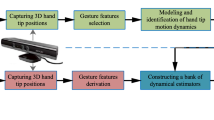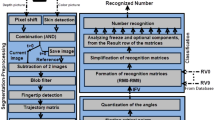Abstract
This paper proposes a vision-based fingertip handwriting recognition system to provide an alternative to input devices. Traditional handwriting recognition systems are limited because they require a specific or expensive input device, such as pen, tablet, or touch panel. Recently, cameras have gradually become standard components in many computer-based products. Therefore, a fingertip and camera combination provides a flexible and convenient input device. The proposed system combines fingertip detection, trajectory feature extraction, and character recognition. First, fingertip moving trajectories are tracked and recoded. The proposed cyclic chain code histograms are then obtained from the trajectories and used as features in the following recognition process. An improved radial basis function (RBF) neural network is used to recognize handwritten characters. Experimental results show that the proposed novel input system is feasible and effective. This study also presents possible applications for camera input devices.












Similar content being viewed by others
References
Lampson, B. W. (2007). Pointing system for pen-based computer. U.S. Patent 7:248 248.
Pavlovic, V. I., Sharma, R., & Huang, T. S. (1997). Visual interpretation of hand gestures for human-computer interaction: a review. IEEE Transactions on Pattern Analysis and Machine Intelligence, 19(7), 677–695.
Jaimes, A., & Sebe, N. (2007). Multimodal human–computer interaction: a survey. Computer Vision and Image Understanding, 108(1–2), 116–134.
Munich, M. E., & Perona, P. (2002). Visual input for pen-based computers. IEEE Transactions on Pattern Analysis and Machine Intelligence, 24(3), 313–328.
Oka, K., Sato, Y., & Koike, H. (2002). Real-time fingertip tracking and gesture recognition. IEEE Computer Graphics and Applications, 22(6), 64–71.
Hsieh, C. C., Tsai, M. R., & Su, M. C. (2008). A fingertip extraction method and its application to handwritten alphanumeric characters recognition. Proceedings of the IEEE International Conference Signal Image Technology and Internet Based Systems, 293–300.
Jin, L., Chen, C., Zhen, L., & Huang, J. (2005). Real-time fingertip detection from cluttered background for vision-based HCI. Journal of Communication and Computer, 2(9), 1–8.
Chen, Z. W., Lin, Y. C., & Chiang, C. C. (2006). The design of a vision-based fingertip writing interface. Proceedings of the IEEE International Conference on Pattern Recognition (ICPR), 2, 104–107.
Lee, D. S. (2005). Effective Gaussian mixture learning for video background subtraction. IEEE Transactions on Pattern Analysis and Machine Intelligence, 27(5), 827–832.
Tavakkoli, A., Nicolescu, M., Bebis, G., & Nicolescu, M. (2008). Non-parametric statistical background modeling for efficient foreground region detection. Machine Vision and Applications, 20(6), 395–409.
Elgammal, A., Duraiswami, R., Harwood, D., & Davis, L. S. (2002). Background and foreground modeling using nonparametric kernel density estimation for visual surveillance. Proceedings of IEEE, 90(7), 1151–1163.
Piccardi, M. (2004). Background subtraction techniques: a review. Proceedings of the IEEE International Conference on Systems, Man, and Cybernetics, 4, 3099–3104.
Stauffer, C., & Grimson, W. E. L. (1999). Adaptive background mixture models for real-time tracking. Proceedings of the IEEE Conference on Computer Vision and Pattern Recognition, 246–252, June.
Elgammal, A., Hanvood, D., & Davis, L. S. (2000) Nonparametric model for background subtraction. Proceedings of the European Conference on Computer Vision 751–767, June.
Sobottka, K., & Pitas, I. (1998). A novel method for automatic face segmentation, facial feature extraction and tracking. Signal Processing. Image Communication, 12, 263–281.
Sobottka, K., & Pitas, I. (1996). Extraction of facial regions and features using color and shape information. Proceedings of the 13th International Conference on Pattern Recognition, 421–425.
Richard, D. G. S., Duda, O., & Hart, P. E. (2001). Pattern Classification: John Wiley and Sons.
Lee, C. C., Chung, P. C., Tsai, J. R., & Chang, C. I. (1999). Robust radial basis function neural networks. IEEE Transactions on Systems, Man and Cybernetics. Part B, 29(6), 674–684.
Wang, Y., Huang, G. B., Saratchandran, P., & Sundararajan, N. (2005). Time series study of GGAP-RBF network: predictions of Nasdaq stock and nitrate contamination of drinking water. Proceedings of the IEEE International Joint Conference on Neural Networks, 3127–3132.
Huang, G. B., Saratchandran, P., & Sundararajan, N. (2004). An efficient sequential learning algorithm for growing and pruning RBF (GAP-RBF) networks. IEEE Transactions on Systems, Man and Cybernetics. Part B, 34(6), 2284–2292.
Fan, K. C., Lin, C. K., & Chou, K. S. (1995). Confusion set recognition of on-line Chinese characters by artificial intelligence technique. Pattern Recognition, 28(3), 303–313.
Li, Y. X., Tan, C. L., Ding, X., & Liu, C. (2004). Contextual post-processing based on the confusion matrix in online handwritten Chinese script recognition. Pattern Recognition, 37, 1901–1912.
Chang, C. C., & Lin, C. J. (2001). Libsvm: a library for support vector machines, available at http://www.csie.ntu.edu.tw/∼cjlin/libsvm.
Acknowledgment
We would like to thank the National Science Council (Grant number: NSC 98-2221-E-155-050) for supporting this work.
Author information
Authors and Affiliations
Corresponding author
Rights and permissions
About this article
Cite this article
Lee, CC., Shih, CY., Yu, CC. et al. Vision-Based Fingertip-Writing Character Recognition. J Sign Process Syst 64, 291–303 (2011). https://doi.org/10.1007/s11265-010-0490-9
Received:
Revised:
Accepted:
Published:
Issue Date:
DOI: https://doi.org/10.1007/s11265-010-0490-9




